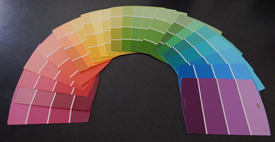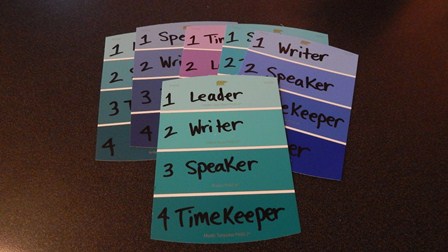Quick Tip: 5 Ways to More Vibrant Lessons
by Elizabeth Mosaidis
As educators, we’re continually looking for new ways to liven up our lessons and make them “pop.” One way to do this is through the use of paint chip samples that you can pick up in any home improvement store. Paint chip samples are a teaching tool that can help you organize your lessons while also making them more engaging for your students. Here are five simple ideas that you can try out immediately in your classroom.

1. Expand Student Vocabulary
I like to introduce the idea of using paint chip samples for vocabulary expansion to the students by writing one of my favorite sayings on the board—“Make every day colorful”—and then eliciting responses from the students about what this means to them. I relate this idea to vocabulary and how we can make our speech more colorful by using new words. To make vocabulary expansion more student centered, have students choose four words that they would like to use in class that day. Instruct them to write down the words and definitions on their paint chip sample. By having the reminder right in front of them, they will be more inclined to use the words, and you can hold them accountable for using the words while speaking or writing, as you are interacting with each group. You can also encourage students sitting in groups to motivate each other to use their words and even quiz each other on the words at the end of class by exchanging cards.
2. Assign Group Roles
Choose a different color for each group and write down and number the main roles within the group, such as leader, writer, speaker, and timekeeper. Spend a few minutes going over the responsibilities of each role and instruct each student from each group to choose a number between 1 and 4. Then it’s time to hand out the group role cards, while also stressing the importance of not changing roles after seeing them.

3. Shades of Meaning
Students can write down phrases for group discussion for agreeing and disagreeing from strongest to weakest, utilizing the shades to indicate the strength of the statements. This can help students to respond quickly in a group discussion setting by associating the statement with a lighter or darker shade and then responding with the appropriate phrase. Alternatively, students could use the shades on the paint chip samples to correspond with degrees of meaning for vocabulary words. For instance, for the word funny, students could write down synonyms, such as amusing, humorous, and hilarious. This would aid students in remembering the degrees of meaning for different words, while also encouraging them to expand their vocabulary.
4. Generate Ideas for a KWL Chart
Instead of having students fill out a worksheet or write in their notebooks, to energize your students, you can have them keep track of what they know (K), want to know (W), and learned (L) on a paint chip sample with 3 shades. By having a smaller space to write on, students can be more concise as they are writing their ideas down.
5. Organize Ideas for a Speech
Before giving speeches, students can write down key words to remind them of the main ideas in their speech. Paint chip samples are bigger than a notecard, making them perfect for writing down key ideas to touch upon. You can even hand out cards with colors that might calm the students down if they are nervous about speaking, such as blue, known for its calming properties.
This is just the tip of the iceberg for how you can use paint chip samples to invigorate your students and make your lessons memorable. How will you use them in your classroom?
Elizabeth Mosaidis is a senior international educator at Arizona State University and a teacher-consultant for the Central Arizona Writing Project.
TESOL Blogs
Interested in writing a blog for TESOL?
Read the submission guidelines and send us your post!
Check out the latest TESOL Blogs:
|
4 Fast Fun Fillers: Games for ELL Break Time, by Tara Arntsen
 Breaks are important, but that does not mean you have to waste them. Choose any of the four activities below to engage students in a fun way without taking up a lot of time either in class or at home. I have mentioned the first two in blog posts of their own, but that was quite a while ago, so I will take this opportunity to refresh your memory before introducing two new resources. Read more. Breaks are important, but that does not mean you have to waste them. Choose any of the four activities below to engage students in a fun way without taking up a lot of time either in class or at home. I have mentioned the first two in blog posts of their own, but that was quite a while ago, so I will take this opportunity to refresh your memory before introducing two new resources. Read more.
|
|
5 Activities to Improve Reading Fluency in Pre-K–5 ELs, by Judie Haynes
 According to Reading Rockets, fluency is composed of three features: accuracy, automaticity, and prosody. These features of fluency are regularly assessed in schools. It’s my opinion, however, that ELs can’t be held to the same standards as their English-speaking classmates while they are still learning English. Reading ability is not a predictor of reading comprehension in ELs (Lesaux & Crosson, 2010). Accuracy may not be a realistic goal for many ELs because they may have difficulty correctly pronouncing the words in a passage. Read more. According to Reading Rockets, fluency is composed of three features: accuracy, automaticity, and prosody. These features of fluency are regularly assessed in schools. It’s my opinion, however, that ELs can’t be held to the same standards as their English-speaking classmates while they are still learning English. Reading ability is not a predictor of reading comprehension in ELs (Lesaux & Crosson, 2010). Accuracy may not be a realistic goal for many ELs because they may have difficulty correctly pronouncing the words in a passage. Read more.
|
|
ELT Best Practices: Getting Your TESOL Conference Proposal Accepted, by Sherry Blok
 Caroline Payant, MA TESL Director and Assistant Professor of TESL at the University of Idaho and President-Elect of WAESOL, shares insights and practices of her recent study, “The Dynamic Rhetorical Structures of TESOL Conference Abstracts” (2016), coauthored with Jack A. Hardy. Caroline Payant, MA TESL Director and Assistant Professor of TESL at the University of Idaho and President-Elect of WAESOL, shares insights and practices of her recent study, “The Dynamic Rhetorical Structures of TESOL Conference Abstracts” (2016), coauthored with Jack A. Hardy.
Sherry Blok (SB): Your recent article, entitled “The Dynamic Rhetorical Structures of TESOL Conference Abstracts” (2016), will be of great interest to many TESOLers as your study examines the rhetorical style of previously accepted TESOL abstracts and presents guidelines for writing successful conference proposals. What prompted your study? Read more. |
|
Feedback in Writing Teacher Education: 3 Suggestions, by Elena Shvidko
 I’d like to continue my conversation about implementing issues related to feedback into teacher training/education programs. In today’s post, I provide three ideas that writing teacher educators can use in their preparatory courses: 1) helping teachers develop their philosophies about feedback, 2) giving teachers tools for continuing professional development, and 3) implementing observations of experienced teachers’ feedback performance. These suggestions are based on an analysis of the literature on teacher feedback. Read more. I’d like to continue my conversation about implementing issues related to feedback into teacher training/education programs. In today’s post, I provide three ideas that writing teacher educators can use in their preparatory courses: 1) helping teachers develop their philosophies about feedback, 2) giving teachers tools for continuing professional development, and 3) implementing observations of experienced teachers’ feedback performance. These suggestions are based on an analysis of the literature on teacher feedback. Read more.
|